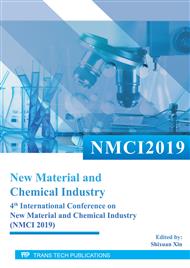[1]
J. Xiao, C. Qiang, A. Nanni, K. Zhang, Use of sea-sand and seawater in concrete construction: Current status and future oppertunities, Constr. Build. Mater. 2017, 155: 1101-1111.
DOI: 10.1016/j.conbuildmat.2017.08.130
Google Scholar
[2]
H. Yin, Y. Li, H. Lv, Q. Gao, Durability of sea-sand containing concrete: Effects of chloride ion penetration, Min. Sci. Technol. (China) 2011, 21: 224-233.
Google Scholar
[3]
W. Liu, H. Cui, Zh. Dong, F. Xing, H. Zhang, T. Y. Lo, Carbonation of concrete made with dredged marine sand and its effect on chloride binding, Constr. Build. Mater. 2016, 120: 1-9.
DOI: 10.1016/j.conbuildmat.2016.05.011
Google Scholar
[4]
W. P. S. Dias, G. A. P. S. N. Seneviratne, S. M. A. Nanayakkara, Offshore sand for reinforced concrete, Constr. Build. Mater. 2008, 22: 1377-1384.
DOI: 10.1016/j.conbuildmat.2007.04.006
Google Scholar
[5]
L. Li, B. Hou, Zh. Lu, F. Liu, Fatigue behaviour of sea sand concrete beams reinforced with basalt fibre-reinforced polymer bars, Constr. Build. Mater. 2018, 179: 160-171.
DOI: 10.1016/j.conbuildmat.2018.05.218
Google Scholar
[6]
O. Shinobu, S. Noriyuki, Sixty - year old concrete in a marine environment. Muroran Inst. Technol. 1987, 37: 173-182.
Google Scholar
[7]
J. Zheng, C.H. Bian, A review of the present situation of the development and utilization of fine aggregate in Japan, Ready-mixed Concr. (Beton Chin. Ed.) 2014, 3: 27–29, 67 (in Chinese).
Google Scholar
[8]
Q. Zhang, P. Wang, W. Wang, Y. Zhang, Marine sand resources in the Pearl River estuary waters of China, J. Mar. Syst. 2010, 82: 583-589.
DOI: 10.1016/j.jmarsys.2010.02.007
Google Scholar
[9]
W. Liu, R. Huang, J. Fu, W. Tang, Zh. Dong, H. Cui, Discussion and experiments on the limits of chloride, sulphate and shell content in marine fine aggregates for concrete, Constr. Build. Mater. 2018, 159: 725-733.
DOI: 10.1016/j.conbuildmat.2017.10.078
Google Scholar
[10]
A. F. Velegrakis, A. Ballay, S. E. Poulos, R. Radzevicius, V. K. Bellec, F. Manso, European marine aggregates resources: origins, usage, prospecting and dredging techniques, J. Coastal. Res. 2010, 51: 1-14.
Google Scholar
[11]
M. Van der Meulen, S. Van Gessel, J. Veldkamp, Aggregate resources in the Netherlands, Netherlands J. Geosci. 2005, 84: 379-387.
DOI: 10.1017/s0016774600021193
Google Scholar
[12]
J. Limeira, M. Etxeberria, L. Agullo, D. Molina, Mechanical and durability properties of concrete made with dredged marine sand, Constr. Build. Mater. 2011, 25: 4165-4174.
DOI: 10.1016/j.conbuildmat.2011.04.053
Google Scholar
[13]
J. Limeira, L. Agullo, M. Etxeberria, Dredged marine sand in concrete: An experimental section of a harbor pavement, Constr. Build. Mater. 2010, 24: 863-870.
DOI: 10.1016/j.conbuildmat.2009.12.011
Google Scholar
[14]
M. Arslan, H. Korkmaz, What is to be learned from damage and failure of reinforced concrete structures during recent earthquakes in Turkey?, Eng. Fail. Anal. 2007, 14: 1-22.
DOI: 10.1016/j.engfailanal.2006.01.003
Google Scholar
[15]
Y. Huang, X. He, Q. Wang, Y. Sun, Mechanical properties of sea sand recycled aggregate concrete under axial compression, Constr. Build. Mater. 2018, 175: 55-66.
DOI: 10.1016/j.conbuildmat.2018.04.136
Google Scholar
[16]
J. Limeira, L. Agullo, M. Etxeberria, Dredged marine sand as a new source for construction materials, Constr. Build. Mater. 2012, 62: 7-24.
Google Scholar
[17]
S. Hasdemir, A. Tugrul, M. Yimaz, The effect of natural sand composition on concrete strength, Constr. Build. Mater. 2016, 112: 940-948.
Google Scholar
[18]
Zh. Dong, G. Wu, Y. Xu, Experimental study on the bond durability between steel-FRP composite bars (SFCBs) and sea sand concrete in ocean environment, Constr. Build. Mater. 2016, 115: 277-284.
DOI: 10.1016/j.conbuildmat.2016.04.052
Google Scholar
[19]
M. Bravo, J. de Brito, J. Pontes, L. Evangelista, Durability performance of concrete with recycled aggregates from construction and demolition waste plants, Constr. Build. Mater. 2016, 77: 357-369.
DOI: 10.1016/j.conbuildmat.2014.12.103
Google Scholar
[20]
B. B. Hope, J. A. Page, J. S. Poland, The determination of the chloride content of concrete, Cem. Concr. Res. 1985, 15: 863-870.
Google Scholar
[21]
BS 882-1992. Specification for aggregates from natural sources for concrete, British Standard, London, (1992).
Google Scholar
[22]
BS EN 12620: 2002. Aggregates for Concrete, British Standard, London, (2002).
Google Scholar
[23]
JASS 5-1979. Reinforced concrete construction, Japanese Architectural Standard Specifications, Japanese Architectural Institute, (1979).
Google Scholar
[24]
JIS A5308-2009. Ready-mixed concrete, Japanese Industrial Standard, Japanese Industrial Standards Committee, (2009).
Google Scholar
[25]
CNS 1240 A2029-2014. Aggregates for concrete, Chinese National Standard, (2014).
Google Scholar
[26]
CS 3: 2013. Aggregates for concrete, Construction Standard, (2013).
Google Scholar
[27]
GB/T 14684-2011. Sand for construction, Chinese National Standard, Beijing, (2011).
Google Scholar
[28]
JGJ 52-2006. Standard for technical requirements and test method of sand and crushed stone (or gravel) for ordinary concrete, Chinese Industrial Standard, (2006).
Google Scholar
[29]
JGJ 206-2010. Technical code for application of sea sand concrete, Chinese Industrial Standard, (2010).
Google Scholar
[30]
EN 1744-1: 2009. Tests for chemical properties of aggregates, European Standard, (2009).
Google Scholar
[31]
ASTM C114-2015. Standard test methods for chemical analysis of hydraulic cement, ASTM Standard, (2015).
Google Scholar
[32]
BS EN 480-10: 2009. Admixtures for concrete, mortar and grout test methods Part 10: Determination of water soluble chloride content, British Standard, (2009).
DOI: 10.3403/01039564
Google Scholar
[33]
W. Shuai, Research about the detection method of the content of the content of chloride ion in the sea sand, China Building Materials Academy, (2016).
Google Scholar
[34]
EN 932-1: 1996, Tests for general properties of aggregates - Part 1: Methods for sampling, European Standard, (1996).
Google Scholar
[35]
EN 932-2: 1999, Tests for general properties of aggregates - Part 2: Methods for reducing laboratory samples, European Standard, (1999).
Google Scholar
[36]
Zh. Zhang, Zh. Chen, L. Liu, Zh. Wang, Principles and applications of marine chemistry, China Ocean Press, 1999: 44-47.
Google Scholar


